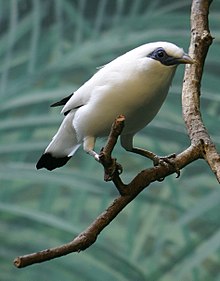The Bali Starling (Leucopsar rothschildi)

The Bali Starling (Leucopsar rothschildi), also known as the Bali Myna or Rothschild’s Myna, is an endemic bird species from Indonesia. This bird is one of the rarest and most strikingly beautiful birds in the world. It is native to Bali, specifically the western part of the island, and is a symbol of Bali’s rich biodiversity. Due to its limited range and declining population, the Bali Starling is critically endangered and has become a focus of conservation efforts.
Physical Characteristics
Plumage:
The Bali Starling is known for its pure white feathers, which cover most of its body, making it look elegant and radiant. It has black tips on its wings and tail, adding a touch of contrast to its appearance.Facial Features:
One of its most distinctive features is the bare, bright blue skin around its eyes, which gives the bird a unique and striking look. It also has a crest of feathers on its head, which it can raise or lower.Size and Shape:
The Bali Starling is medium-sized, about 25 cm (10 inches) in length. It has a sturdy, straight beak that is light gray with a yellow tip and grayish legs.
Habitat and Distribution
Natural Habitat:
Bali Starlings inhabit tropical forests, savannas, mangroves, and coastal woodlands. They prefer areas with plenty of trees and open spaces where they can perch and forage.Endemic Range:
This bird is only found naturally in Bali, particularly in the western region near the Bali Barat National Park. It is not found in the wild outside this region.
Behavior and Ecology
Social Behavior:
Bali Starlings are social birds that are often seen in pairs or small flocks. They communicate using various calls, including melodious whistles, chirps, and chattering sounds.Feeding Habits:
These birds are omnivores. Their diet consists of fruits, berries, seeds, insects, and other small invertebrates. They often forage in trees and on the ground.Reproductive Behavior:
- Breeding Season: The breeding season occurs during the rainy season when food is abundant.
- Nesting: Bali Starlings nest in tree cavities, where they lay 2–3 eggs.
- Parental Care: Both parents share responsibilities for incubating the eggs and feeding the chicks after they hatch.
Cultural Significance
Symbol of Bali:
The Bali Starling is considered a symbol of Bali's natural beauty and cultural richness. It is often called the “Bird of Bali” and is featured in local art and conservation campaigns.Traditional Beliefs:
In Balinese culture, the bird is regarded as a sacred creature and is often associated with purity and grace.
Conservation Status
Threats:
- Habitat Loss: Deforestation and land-use changes in Bali have severely impacted the bird’s habitat.
- Poaching and Illegal Trade: The Bali Starling is highly sought after in the exotic pet trade due to its beauty and rarity. This has led to a dramatic decline in its population in the wild.
Current Population:
The Bali Starling’s population in the wild is estimated to be fewer than 100 individuals, making it critically endangered according to the International Union for Conservation of Nature (IUCN).Conservation Efforts:
- Breeding Programs: Captive breeding programs have been established to increase the population. Birds raised in captivity are often released back into the wild.
- Protected Areas: The Bali Barat National Park serves as a key refuge for the Bali Starling.
- Awareness Campaigns: Local and international efforts have been made to educate people about the importance of protecting this species.
- Anti-Poaching Measures: Increased patrols and stricter enforcement of laws aim to prevent illegal hunting and trading.
Interesting Facts
Scientific Name:
The Bali Starling was named Leucopsar rothschildi to honor Walter Rothschild, a British zoologist who first described the species in 1911.National Bird of Bali:
It is officially recognized as Bali’s mascot and represents the island’s commitment to biodiversity conservation.Captive Population:
The Bali Starling has a larger population in captivity than in the wild. These captive populations play a crucial role in ensuring the species’ survival.Unique Behavior:
When threatened or displaying aggression, the Bali Starling can puff up its feathers and raise its crest, making it appear larger and more intimidating.
Conclusion
The Bali Starling is a remarkable bird that embodies the natural beauty and biodiversity of Bali. Despite its critical conservation status, dedicated efforts from conservationists, local communities, and the government provide hope for its survival. Protecting the Bali Starling not only ensures the preservation of this iconic species but also highlights the importance of conserving Bali’s unique ecosystems for future generations.
Komentar
Posting Komentar